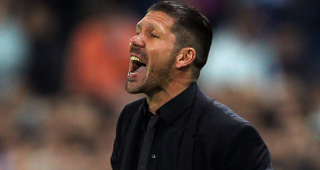Diego Simeone will have managed Atletico Madrid for seven seasons after shortening his contract to expire in 2018 last week. The timing of the announcement baffled many analysts, yet the relationship between Simeone, Atleti and their supporters survives by its own logic. Having never managed his six previous clubs longer than two seasons, the most surprising detail is that Simeone has stayed in one place this long. But there is no team in the world more linked with the identity of their manager than Atleti and Simeone. In short, Atleti is Simeone.
Two weeks earlier, Simeone’s announcement may have signaled a larger burn out. Atleti began the season with a 1-1 draw against Alaves and a 0-0 draw against Leganes, both newly promoted sides. The second result was especially concerning as Antoine Griezmann uncharacteristically broke rank and said Atleti were fighting the relegation zone. New signing Kevin Gameiro was expected to replace a Diego Costa sized hole as the furthest forward striker, and he only had a penalty goal to show for the $40 million dollar transfer. Was this the season La Liga figured out Simeone? Or would his team tire of him first?
As quickly as those questions were asked, Atleti bounced back as they have done so often in the past three seasons. This time, the attack lead the way. They scored 4 against Celta Vigo, won a trademark 1-0 match against PSV in Champions League, and hit another 5 against Sporting Gijon before drawing with Barcelona 1-1 on Wednesday. Atleti have tried to piece together a cohesive attack with their transfer window signings to fit the structure of Simeone’s 4-4-2 approach, as it’s thought that this would be the one area that could turn the side from efficient to transcendent. Mario Mandzukic and Jackson Martinez were big money transfers expected to take over Diego Costa’s tireless role up front, and are no longer with the club. Arda Turan summed up life as an attacker under the manager by asking for a transfer to Barcelona because he ran too much. Gameiro and Nicolas Gaitan stepped up to the challenge this summer.
The early La Liga results were another reason why supporters shouldn’t panic in August, as Atleti continue to round into form. No manager this side of Pep Guardiola or Jurgen Klopp inspires more think pieces than Simeone has in the last three seasons, but perhaps he doesn’t get enough credit for his subtle, tactical changes within his defensive structure. In addition to his bread and butter 4-4-2 formation, Simeone unveiled a 4-1-4-1 formation in Champions League matches that sacrificed none of Atleti’s trademark compactness while also introducing Saul as a mainstay in the lineup. It wasn’t the possession style many expected with the addition of Carrasco and Luciano Vietto last summer. But that also wouldn’t be the Atleti we’ve become enamoured with.
A development in Atleti’s attacking phase this season was to stop playing four central midfielders at once - at least not against smaller sides prone to parking the bus. The midfield four against Sporting Gijon featured Gaitan and Carrasco on the wings with Koke and Saul in the middle. Their possession strategy focused on creating overloads on the left side between Saul, Luis, Griezmann and Carrasco, with two goals developed on that side.
Otherwise, the playmaking responsibilities fall to Koke. Still just 24, he created more goal scoring chances through the first three games than Toni Kroos or Messi. If Griezmann is to score the goals to bail out the side, then it’s up to Koke to provide the passing, preferably from center midfield depending on the opponent. In a 1-1 draw against Barcelona, Gabi returned to anchor the middle with Saul, pushing Koke to right midfield. After withdrawing Gameiro and Saul for Fernando Torres and Correa in the second half, the new striking partnership combined to score off a quick thinking set piece that caught Barcelona’s defense off guard.
It is important to remember that Simeone had managerial success outside of Atleti. As documented in Jonathan Wilson’s Angels With Dirty Faces, the 2007 Estudiantes side he managed reflected best what Simeone wants in a team with “practicality, commitment, collective effort, talent, simplicity”. That side gave up just 12 goals in 19 matches in winning its first trophy in 23 years. There is also this headline from 2008 that reads “Simeone Guides River Plate From Turmoil to Title” which goes into length his challenge of turning a River Plate side wrought with political disorder into champions (the piece ends with the author declaring that she wouldn’t be surprised if he were managing Atleti in the Champions League finals in 2010, off by only three years). He does seem to have a type: underachieving sleeping giants with talented players. At Estudiantes, he had Juan Sebastian Veron. The 2008 River Plate team featured Falcao and Alexis Sanchez. The 2013 Atleti side had Diego Costa and David Villa. There is no secret of his desire to manage Internazionale one day.
Likewise, there was an Atletico Madrid before 2011 when Simeone took over as manager. Opened in 1967, the Vicente Calderon Stadium is home to five La Liga titles, and perhaps one more this year before Atleti move into a new stadium for the start of 2017. It is significant that Simeone stayed as manager to bridge the eras in club history. After all, Simeone cannot manage Atleti forever, but the memories will sustain for decades in their new stadium. For now, the Champions League is the only trophy that eludes him and his side. He contemplated quitting after the emotional loss against Real Madrid in last season’s final. Simeone and Atleti have two more chances to reach the European pinnacle.



